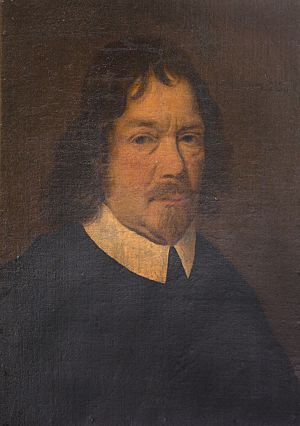William Pole (antiquary) facts for kids
Sir William Pole (1561–1635) was an important English gentleman. He lived in Colcombe House and Shute House in Devon, England. Sir William was a landowner, an investor in new colonies, and a Member of Parliament. He is most famous for being a historian and an antiquarian of Devon County. An antiquarian is someone who studies old things and history.
Contents
Sir William Pole's Life and Work
Sir William Pole was born on August 27, 1561, in Colyton, Devon. His father, also named William Pole, was a Member of Parliament. His mother was Katherine Popham. Her brother, John Popham, became a very important judge.
In 1578, William Pole began studying law. He became a justice of the peace for Devonshire. This meant he helped keep law and order in the area. From 1602 to 1603, he served as the High Sheriff of Devon. This was a high-ranking local government job. In 1586, he was elected as a Member of Parliament for Bossiney, Cornwall.
King James I knighted him in 1606. This means he was given the title "Sir." Sir William also invested money in the Virginia Company. This company helped set up English colonies in America.
Studying History
Sir William Pole spent much of his life researching history. He wrote many books and papers about the history of Devon. These were never published during his lifetime. His writings covered the history of old families, their land, and their family symbols.
His work was very important for later historians. They used his notes to write their own books about Devon. Sir William said he found his information in old records. These records came from places like the Tower of London and the Exchequer. The Tower of London was a main place for storing important historical documents.
Some of his writings were lost during the Civil War. But many survived, including:
- Two large books that were published in 1791. They were called Collections Towards a Description of the County of Devon.
- A book of old deeds and agreements from 1616.
- A book about family symbols and coats of arms.
- A book of deeds and grants related to Tor Abbey.
Other historians, like Tristram Risdon and John Prince, used Pole's work. They found his research very helpful for their own books.
What People Thought of His Work
Tristram Risdon, another historian, praised Sir William Pole. He said Pole was the "most accomplished treasurer of the antiquities of this county." This means he was the best at finding and keeping old historical facts about Devon. Risdon also said Pole had an amazing memory. He could remember the family histories of many important families.
Today, Pole's collections are still very valuable. They contain information from documents that are now lost. However, his work mainly focused on the rich and powerful families of Devon. It didn't include much about other people in society.
Family Life

Sir William Pole was married twice. His first wife was Mary Peryam (1567–1605). She was the daughter of Sir William Peryam, a judge. William and Mary had six sons and six daughters.
Some of their notable children included:
- Sir John Pole, 1st Baronet (c.1589–1658), who became his main heir.
- William Pole (1593–1674), who moved to America and died there.
- Elizabeth Pole (1588–1654), who also moved to America. She helped found the town of Taunton, Massachusetts in 1639–40.
His second marriage was to Jane Simmes (died 1653). They did not have any children together.
Death
Sir William Pole passed away on February 9, 1635. He was 73 years old. He died at his home, Colcombe Castle, in Colyton. He was buried in Colyton Church. There is a simple stone on the floor marking his grave.
Sources
- Pole, Sir William, Collections Towards a Description of the County of Devon, Sir John-William de la Pole (ed.), London, 1791.
 This article incorporates text from a publication now in the public domain: "Pole, William (1561-1635)". Dictionary of National Biography. (1885–1900). London: Smith, Elder & Co.
This article incorporates text from a publication now in the public domain: "Pole, William (1561-1635)". Dictionary of National Biography. (1885–1900). London: Smith, Elder & Co.



